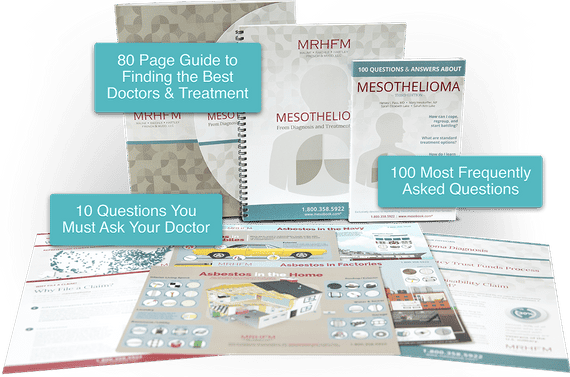
If you’re a veteran diagnosed with mesothelioma, you want to know what your best treatment options are and how you can improve your prognosis. Our trusted resource gives you all of those answers and more — for free.

Even though the Navy endured more asbestos exposure than other military branch, all veterans should understand how they may have come into contact with asbestos during active duty.
Out of all the military branches, Navy veterans run the highest risk of developing mesothelioma because their branch used the most asbestos.

Asbestos use peaked during WWII when the government needed manufacturers that could cost-effectively use the naturally fire-resistant mineral to protect ships against fire at sea.
Because it was fire resistant and versatile, asbestos was used on every part of the ship, from the boiler room to sleeping quarters. As a result, Navy servicemen faced heavy exposure to mesothelioma cancer-causing fibers. Because millions of people serving in WWII alone were exposed to asbestos-containing products, Navy veterans diagnosed with mesothelioma need to understand how they were exposed to asbestos and what their options are.
The War Related Illness and Injury Study Center declared the following Navy servicemen to be the most at-risk:
These Navy personnel came into contact with asbestos-containing materials on a daily basis:
Asbestos was nearly everywhere on almost every ship built by the Navy between the 1930s and 1970s. The Navy used asbestos to insulate the close quarters below decks and fireproof hazardous boiler rooms. The fire-resistant mineral was used in every part of the ship, including:
Many Navy personnel had to perform their daily tasks in tight quarters that lacked adequate respiratory protection, including removing and re-wrapping damaged pipe with more asbestos-containing lagging and asbestos paste.
The Navy’s used asbestos in places other than ships. Up until the early 1990s, bases and military housing were built with asbestos-containing material and were torn down without proper protection against the microscopic asbestos fibers.
Because ships with asbestos-containing materials were often built up and broken down in shipyards, they became the most dangerous place for asbestos exposure. These activities often released large amounts of asbestos dust into the air, affecting servicemen, dockworkers and anyone in the vicinity of the shipyard.

The Army used asbestos extensively as a construction material from WWII to the mid 1970s in everything from bases and barracks to several parts of operational vehicles.

Some Army occupations ran a higher risk of asbestos exposure than others. These occupations include:
Because of its versatility, the Army used asbestos-containing materials in many different places throughout bases, including sleeping areas, mess halls and more. It was also found in cement foundations, caulking used to seal joints and seams, in flooring and as insulation in the plumbing system. Specific Army buildings and equipment in which asbestos-containing materials can be found include:
During the 1990s, the Army initiated a program to clean up 40 closed or realigned installations. Not surprisingly, asbestos was a major contaminant in all of them. As of 2002, two major Army sites, Fort Jackson and Fort Knox, still had asbestos within their infrastructure. And asbestos was used in seven of the buildings at the Walter Reed Army Medical Center.

Marines who were in active service from the 1930s to 1970s were at a heightened risk of exposure in housing units, on ships and in land bases.

Marines who worked in the following occupations before the 1970s are likely to have encountered asbestos during active duty:
Due to their versatile deployment, Marines encountered asbestos in a variety of places:
Often deployed along with the Navy, Marines served on vessels that contained asbestos in every section of the ship, from the bridge and officers quarter to the engine room and boiler room. In addition, Marines also spent a lot of time in shipyards, where microscopic asbestos particles were released into the air as ships were constructed and maintained.
Marines may have also encountered asbestos while training. In 2009, the American Recovery and Reinvestment Act (ARAA) awarded several millions of dollars to help construction companies renovate and remove asbestos from Parris Island, the Marines’ most famous training camp. Although the renovations were completed in 2010, it was decades too late for the thousands of Marine recruits who had already trained at the camp.

Like other branches of the military, the Air Force at the beginning of WWII recognized asbestos’ natural heat resistance made it the perfect material for the construction of planes. As the usage of asbestos in planes and in bases grew during WWII, so too did the number of Air Force veterans who were exposed to its cancer-causing properties.

Although every Air Force veteran risked some asbestos exposure, Air Force mechanics were especially vulnerable.
Brake pads, a crucial component of planes, were a common site of intense friction and were often coated with asbestos insulation to guard against friction fires. Because they were exposed to such intent heat, the brake pads’ microscopic fibers would eventually break free from the lining. So, as Air Force mechanics would change the brakes or perform routine maintenance on the aircraft, they’d unknowingly be exposed to those loose fibers.
Most asbestos exposure for Air Force veterans came from using and maintaining planes. Asbestos was used in a plane anywhere fire damage was a concern, such as in the cockpit, the engine and electrical components throughout the plane.
Air Force veterans may have been exposed to asbestos-containing materials in the following applications:
Air Force bases were also constructed using asbestos-containing materials, insulating the walls of sleeping quarters in barracks and the pipes running through the walls of the base.
Chanute Air Force base, one of the first few airbases opened in the early part of the 20th century, used asbestos in some of its key structures, such as in its largest building (White Hall). After the base closed in 1993, the Air Force initiated a clean up effort to remove asbestos and other toxic substances.

The majority of asbestos exposure for Coast Guard veterans occurred on ships produced from WWII to the Vietnam War. Because they knew it protected the fleet from fire at sea, asbestos was used everywhere on the ship, from the boiler room to the insulation in a ship’s sleeping quarters. Consequently, Coast Guard veterans spent extended periods of time in the cramped, poorly ventilated quarters of ships constructed with asbestos. Veterans also spent a lot of time in shipyards where ships containing asbestos were produced and demolished.

Shipyard workers were the most at risk occupation in the Coast Guard because they’d be involved in the construction or demolitions of ships that contained asbestos. As they worked, asbestos fibers released into the air and increased their asbestos exposure and risk of developing mesothelioma. Older ships, especially those serving in the Korean War and Vietnam War, were reused, making the asbestos inside the ships brittle. Eventually, they’d release microscopic fibers that could be inhaled by servicemen and women.
Knowing fire damage posed a serious threat to the integrity of the ship and its servicemen, every ship constructed before the 1980s contained some form of asbestos. The most common locations of asbestos on Coast Guard ships include:
Shipyards were also a center for asbestos exposure. A recent study on workers employed at Coast Guard shipyards from 1950 to 1964 reported that exposure to asbestos was widespread in shipyards and strongly linked to increased incidences of mesothelioma.

If you’re a veteran with mesothelioma caused by service-related exposure to asbestos, you are eligible for disability compensation and medical benefits from the VA.

Supplemental Income: VA benefits provide extra income to veterans unable to work, whatever their financial needs may be.
High Approval Rate: Most veterans with mesothelioma are approved for disability benefits and treatment through VA hospitals, including financial benefits for the veteran’s caregivers and family members.
If you’re a veteran diagnosed with mesothelioma, or another service-connected disability, you must meet a number of criteria to qualify for benefits and disability compensation.
To file a claim, you must have been:
Other military members who may be eligible for benefits include commissioned officers from the Public Health Service, Environmental Sciences Services Administration, or National Oceanic and Atmospheric Administration (or its predecessor, the Coast and Geodetic Survey).

Mesothelioma affects every patient differently. Cell type, cancer stage and location of the tumor all play a decisive role in creating an individual treatment plan.
Veterans should remember they can choose to receive treatment at any facility, not just those that are in the VA network. Always choose the treatment center that best fits your needs.
In order to approve you for benefits and disability compensation, the VA requires several forms — including a detailed exposure summary. Filing a claim can be a complex, so our Veterans Help Team is available to assist with every aspect, from filling out forms to submitting paperwork. They keep the claims process on track, assist in the completion and review of paperwork, and will be your advocate if you’re denied. The free services they perform are listed below.
The VA will require an exposure summary as proof that your disability occurred during active duty. An exposure summary details where, how, and for how long you were exposed to asbestos. We help write your exposure summary and make sure it meets the VA’s standards.
You have a right to appeal a claims denial. Our Veterans Help Team members know the VA claims process in and out and can help you reapply for the benefits you deserve.
The claims process is complicated, and you can easily miss out on benefits. If you’ve already applied and have been approved, we can review your claim and make sure you’re getting everything you’re entitled to.
We’re here to answer any question about mesothelioma, asbestos, treatment or any other matter related to your diagnosis. If you’re uncertain about what to do, or just need to speak with a person who’s knowledgeable about mesothelioma, contact us.

Mesothelioma Cancer Community, Sponsored by Maune Raichle Hartley French & Mudd, LLC.
Disclaimer: The information provided by MesotheliomaCancer.org is not a substitute for professional medical advice.
